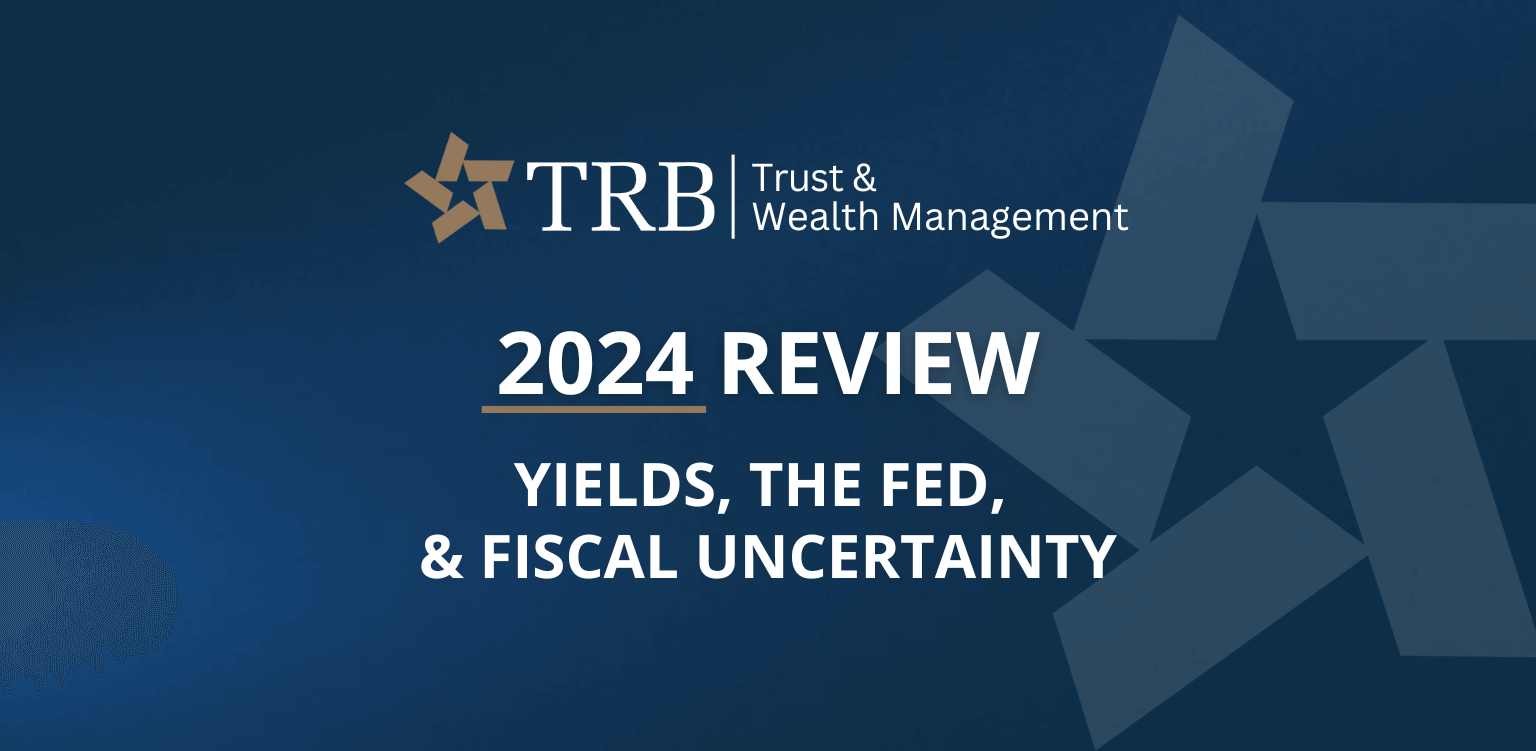Last updated: March 19, 2025
Over the past 5 years, the yield on the benchmark US 10 Year Treasury has moved from the 1.9% level in 2019, through the looking glass of quantitative easing to a low yield of 0.31% during the global-pandemic panic in March 2020, and now, after several years of titanic government deficit spending, to 4.52% with an eye toward the 5% 2023 high. The good news is that investors can finally generate an attractive return on fixed income, but the bad news is the cost of borrowing weighs on growth. Our concern is that yields may be the story of the next several years, though potentially not the story investors want to hear.

Source: Texas Regional Bank Trust & Wealth Management, Bloomberg
We wrote a short piece on election night describing the overnight increases in bond yields as a Trump victory became apparent to markets (Post-Election Note), pointing out that the bond market may serve as an unexpected check on this administration’s policy options even if slim majorities in both houses of congress do not. This potential challenge has grown in the months after the election as rates have continued to rise, even in the face of an easing campaign from the Federal Reserve. Beginning on September 18, the Fed has cut rates three times for a total of 0.75%, but, as the accompanying table shows, interest rates across the curve have increased, with the benchmark 10-year yield up over 80 basis points during what was intended to be a multi-month ‘easing’ cycle.
The fact that rates across the curve are increasing in the face of cuts is noteworthy and of concern, bringing to mind the term ‘bond vigilantes’, whose impact was felt during the Clinton years when investors concerned about US fiscal policy pushed 10 year US treasury yields from 5% to over 8%, threatening the health of the economy and forcing a Democratic president to change course and, along with Newt Gingrich, successfully confront the nation’s deficit.

Source: Texas Regional Bank, Dept of the Treasury
Today’s budgetary challenge is more substantial. The national debt was $4.2 trillion when Clinton came into office and $5.7 trillion at the end of his term, though his administration achieved budget surpluses and stopped the bleeding. Today the national debt is over $36 trillion, and the annual deficit is near $1.8 trillion.
Our government pays an average 3.3% interest rate on the current debt, substantially higher than the 1.5% rate being paid ten years ago when both interest rates and the amount of debt were much lower, so current interest payments approximate $900 billion, over 13% of the annual United States budget! Borrowing to pay interest is, unfortunately, the definition of a debt spiral and the harsh reality is, all else being equal, the rest of the world will demand compensatory rates to finance a deteriorating United States balance sheet.
While the Trump administration has provided interesting rhetoric around cutting expenses from the budget, including the Department of Government Efficiency (DOGE), the administration’s goals, and the reality of the challenge, imply falling far short of a balanced budget. The bond market, watching the US debt level continue to grow as interest on the existing debt adds to borrowings, may force the administration to a different path. In the interim, continued higher rates will be difficult for a US stock market trading at high valuations, and the yield on the US 10 year will have a hand in shaping equity markets in 2025.

Source: Bloomberg, Texas Regional Bank Trust & Wealth Management
Summary
We live in interesting times, but in 2024 that timeworn challenge failed to diminish a trend of historic gains. As we consider the year in perspective, a number of data points emerge that bear scrutiny, to include an all-time high in concentration percentage among the largest stocks in the S&P 500, valuations that are high by historical standards, a President that is willing to diverge from the economic structure of recent decades, stubborn inflation that can’t quite fall to the 2% Federal Reserve target, and a big change in the level of interest rates relative to the lows of a few years ago. Even the multi-year performance of the S&P 500, while positive for investors over the last two years, could be added to that list.
TRB Trust & Wealth Management manages portfolios for a wide range of clients, with approaches customized for different assets, structures, goals, and investment horizons. Our preferred perspective is always long-term with a focus on growth and compounding assets, and many of our conversations with clients are based around that long-term outlook. The very best thing for clients over extended time periods is to hold through the day-to-day, or even the year-to-year noise, adding to their investments when fear and volatility create opportunity, and reallocating to capitalize on market strength. Our long-term investment focus does not, however, prevent us from making tactical changes in portfolios, and the focus at this juncture should be adjustments toward areas of the market that have been left behind by some of the challenges discussed in this note.
This includes stocks, active managers, and indices with value orientations as well as some blend of value with small and mid-sized capitalization focus. Additionally, while capitalization-weighted large-cap indices have significant concentration and valuation issues, equal-weighted indices allow similar exposure to large stocks with less of those concerns. International and emerging market indices also fit into this category, particularly after years of underperformance as well as more attractive valuations than we see in the US, though investors must be prepared to weather volatility in any geography that becomes caught up in abrupt changes to US trade policy.
Economies and markets never lack concerns and catalysts, and it is our job to incorporate risks and opportunities into long-term portfolio construction. We have a strong and growing team across the state, and it is a good idea to check in with your advisor to discuss your perspective and confirm that goals and portfolio allocations are appropriate relative to the potential for market volatility.
This article is an excerpt of a larger work by Chief Investment Officer Trey Willerson. In his 2024 Year End Review, Willerson provides an in-depth analysis of the key economic and market trends that shaped the past year, offering insights into what may lie ahead for investors. Read the full article here.
Investment and insurance products: NOT FDIC INSURED | MAY LOSE VALUE | NO BANK GUARANTEE
TRB Wealth Management, LLC is a Registered Investment Advisor with the Securities and Exchange Commission
Form CRS | Form ADV | Advisor Info
TRB Wealth Management, LLC does business in the name of TRB Trust and Wealth Management. Trust and Family Office services offered exclusively through Texas Regional Bank. The trust department of Texas Regional Bank has engaged TRB Wealth Management, LLC to provide investment advice to Texas Regional Bank for trust department accounts.






